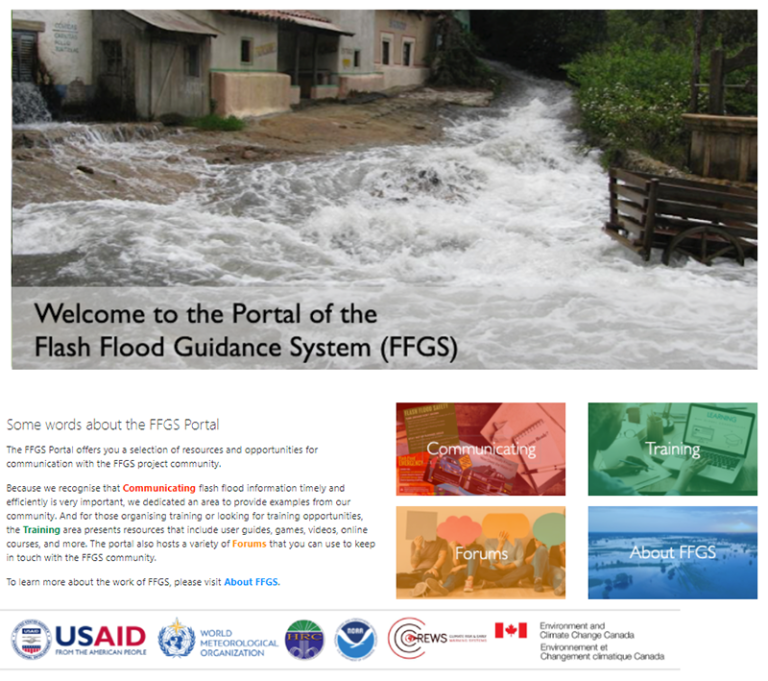Flash Flood Guidance System (FFGS) with Global Coverage
FFGS Sustainability Strategy
Based on the findings of an external Review of the Global FFGS and the outcomes of the Global FFGS Workshop in 2019, the FFGS Sustainability Strategy was developed with the goal of providing the vision and approaches to be taken to help attain sustainability of the FFGS.
The Sustainability Strategy for the FFGS identified four critical factors:
- Developing an inclusive and broadened governance model;
- Increasing and strengthening the training effort;
- Increasing visibility of the FFGS; and
- Developing additional financial and human resource support.
This Strategy was approved by the Hydrological Assembly and World Meteorological Extraordinary Congress in October 2021 (Cg-Ext 2021). It is accessible here.
FFGS Governance
Terms of Reference
Meetings
- 1st FFGS Programme Management Committee (PMC) meeting (May 2023, Skopje, North Macedonia)
- 2nd FFGS PMC meeting, joint PMC-EG meeting, and EG meeting (December 2024, Istanbul, Türkiye)
Regional and National FFGS projects
- Black Sea and Middle East FFGS: Armenia, Azerbaijan, Bulgaria, Georgia, Jordan, Lebanon, Israel and Türkiye (RC);
- Central Asia Region FFGS: Kazakhstan (RC), Kyrgyzstan, Tajikistan, Turkmenistan and Uzbekistan;
- Central America FFGS: Costa Rica (RC), Belize, El Salvador (back-up RC), Guatemala, Honduras, Nicaragua and Panama;
- Haiti and Dominican Republic FFGS: Dominican Republic (RC) and Haiti;
- Mekong River Commission FFGS: Cambodia (RC is Mekong River Commission (MRC)), Lao People's Democratic Republic, Thailand and Viet Nam;
- Myanmar FFGS
- Northwest South America FFGS: Colombia, Ecuador, Peru (RC)
- Southern Africa Region FFGS: Botswana, Lesotho, Malawi, Mozambique, Namibia, South Africa (RC), Eswatini, Zambia and Zimbabwe;
- Pakistan and Afghanistan Regional FFGS: Pakistan (RC) and Afghanistan;
- South Asia FFGS: Bangladesh, Bhutan, India (RC), Nepal and Sri Lanka;
- Southeast Asia FFGS: Cambodia, Lao People's Democratic Republic, Thailand and Viet Nam (RC);
- Southeastern Asia-Oceania FFGS: Brunei Darussalam, Indonesia (RC), Malaysia, Papua New Guinea, Philippines, and Timor-Leste;
- South East Europe FFGS: Albania, Bosnia and Herzegovina, Croatia, Moldova, Montenegro, Romania, Serbia, Slovenia, North Macedonia, and Türkiye (RC);
- West and Central Africa FFGS: Angola, Benin, Burundi, Cabo Verde, Central African Republic, Côte d’Ivoire, Equatorial Guinea, Gabon, Ghana, Liberia, Rwanda, Sao Tome and Principe, Senegal (RC), Sierra Leone, Togo, Cameroon, Democratic Republic of the Congo, Chad, Guinea, Guinea-Bissau, Mauritania, Nigeria, The Gambia, Burkina Faso, Mali and Niger (RC);
- South West Indian Ocean FFGS: Comoros, Madagascar, Mauritius and Seychelles;
- Pacific FFGS: Fiji (RC), Samoa, Solomon Islands, Tonga and Vanuatu.
Training Program
For more information about the extensive FFGS training program and the Moodle platform, please click on the image below:
FFGS Global Workshops
To learn more about the largest global FFGS events, the FFGS Global Workshops, please click on the following links:
- First FFGS Global Workshop (4-8 November 2019, Antalya, Türkiye)
- Second FFGS Global Workshop (19-23 June 2023, Skopje, North Macedonia)
______________________________________________________________________________________________________________
To obtain more information, please watch the video below or contact WMO at: ffgs wmo [dot] int (ffgs[at]wmo[dot]int)
wmo [dot] int (ffgs[at]wmo[dot]int)


